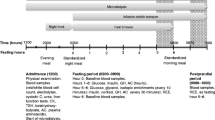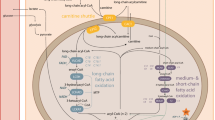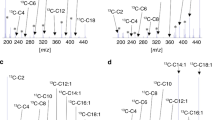Abstract
The in vivo oxidation of fatty acids (FA) of different chain length was investigated in three patients with documented mitochondrial FA oxidation disorders: one patient with mild multiple acyl-CoA dehydrogenase deficiency (MADM), one with medium chain acyl-CoA dehydrogenase deficiency (MCAD), and one with carnitine palmitoyltransferase I deficiency (CPT I). Breath tests were performed after oral administration of 1-13C butyric, 1-13C octanoic, and 1-13C palmitic acids. 13C/12C ratio in the expired oxidative end product CO2 was measured. The cumulative 13C elimination was calculated and expressed as a percentage of the administered dose. In the MADM patient the influence of carnitine therapy (or deprivation) on the utilization of 1-13C palmitic acid was also examined. In the MCAD and CPT I patients, the 1-13C butyric, 1-13C octanoic and 1-13C palmitic acids in vivo oxidation were similar to five healthy controls. In the MADM patient, the oxidation of 1-13C butyric and 1-13C octanoic acids were normal, whereas the metabolism of 1-13C palmitic acid ranged from 33% to 66% of controls. In this patient the serum carnitine level decreased from 60 to 27 μmol/l without carnitine supplementation. Clinically there was mild hypotonia. 1-13C palmitic acid oxidation compared to controls was 50%. After 2 further weeks of carnitine deprivation the serum carnitine was 10–15 μmol/l. Clinically he was very hypotonic and had a large liver. 1-13C Palmitic acid oxidation was 33%. After 6 weeks of readministration of carnitine (l-carnitine 100 mg/kg/day p.o.) the serum carnitine was 60 μmol/l and the patient was in good clinical condition. 1-13C palmitic acid oxidation was 66% compared to controls. Our study implies that this simple fatty acid breath test is not of diagnostic use for detection of enzymatic defects in FA oxidation disorders. The carnitine dependent 1-13C palmitic acid oxidation indicates that this test might be of some value in cases with primary or secondary carnitine deficiencies.
Similar content being viewed by others
Author information
Authors and Affiliations
Rights and permissions
About this article
Cite this article
Jakobs, C., Kneer, J., Martin, D. et al. In vivo stable isotope studies in three patients affected with mitochondrial fatty acid oxidation disorders: Limited diagnostic use of 1-13C fatty acid breath test using bolus technique. Eur J Pediatr 156 (Suppl 1), S78–S82 (1997). https://doi.org/10.1007/PL00014278
Issue Date:
DOI: https://doi.org/10.1007/PL00014278




